
Heteropteryx is a monotypic genus of stick insects containing Heteropteryx dilatata as the only described species. and gives its name to the family of the Heteropterygidae. Their only species may be known as jungle nymph, Malaysian stick insect, Malaysian wood nymph, Malayan jungle nymph, or Malayan wood nymph and because of their size it is commonly kept in zoological institutions and private terrariums of insect lovers. It originates from the Malay Archipelago and is nocturnal.

The Heteropterygidae is a family of stick insects belonging to the suborder Euphasmatodea. Species can be found in Australasia, East and Southeast Asia. About 150 valid species have been described.

The Obriminae are the most species-rich subfamily of the Phasmatodea family Heteropterygidae native to Southeast Asia. It is divided into two tribe.

Datamini is the only tribe within the subfamily of the Dataminae from the order of the Phasmatodea. The representatives of this subfamily are on average not as large as those of the other two subfamilies belonging to the family of Heteropterygidae.

Heteropterygini is the only tribe within the subfamily of the Heteropteryginae. With 19 representatives described, this subfamily includes the fewest species of the three subfamilies, but includes the largest and most striking species of the family.

Hoploclonia is the only genus of the tribe Hoplocloniini and brings together relatively small and darkly coloured Phasmatodea species.

The Obrimini are the most species-rich tribe of the Phasmatodea family of the Heteropterygidae native to Southeast Asia.
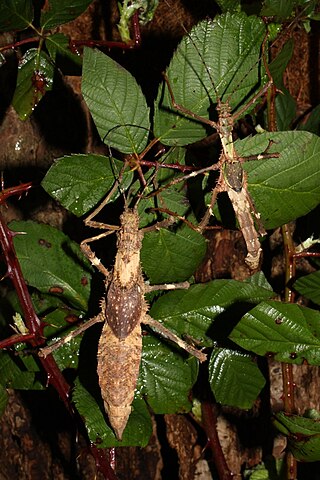
Haaniella is a genus of the Phasmatodea family Heteropterygidae from Southeast Asia.
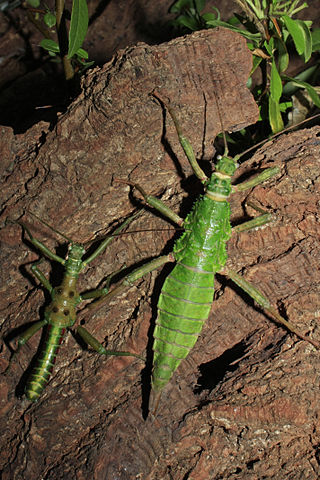
Mearnsiana is a genus of stick insects, which is native to the Philippine islands Mindanao, Leyte and Dinagat.

Mearnsiana bullosa, occasionally referred to by the common name Manobos stick-insect,is a species of stick insect in the family Heteropterygidae. It is native to the Philippine islands of Mindanao and Leyte. Until 2023 it was the only described representative of the genus Mearnsiana.
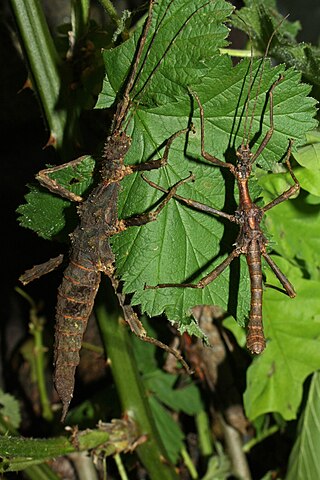
Trachyaretaon is a genus of stick insects native to the Philippines.

Eubulides is a stick insect genus native to the Philippines.

Theramenes is a genus of medium-sized stick insects in the tribe Obrimini, which is native to the Philippines and to the Indonesian Talaud Islands.
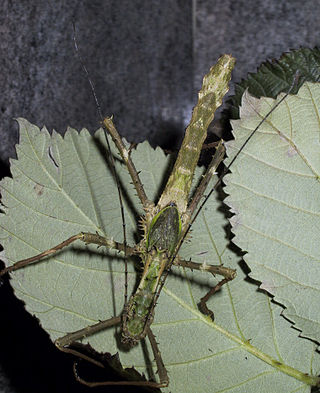
Haaniella erringtoniae is a stick insect species. It is a typical representative of the subfamily Heteropteryginae. The occasionally used common name Errington's Haaniella refers to the species name.
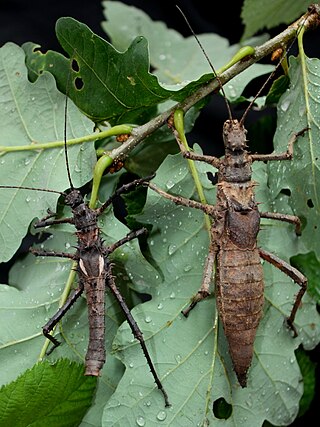
Haaniella dehaanii is a stick insect species. It is a typical representative of the subfamily Heteropteryginae. The occasionally used common name De Haan's haaniella refers to the species name.
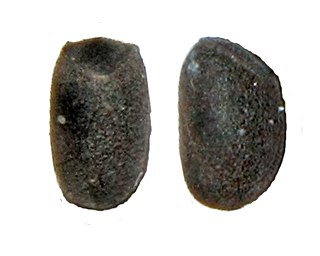
Stenobrimus is a genus of medium-sized stick insects native to the Philippines.

Haaniella gintingi is a stick insect species from Sumatra. It is a typical representative of the subfamily Heteropteryginae. The occasionally used common name Ginting's Haaniella refers to the species name.

Haaniella saussurei is a species of stick insect native to Borneo and a typical representative of the subfamily Heteropteryginae. The occasionally used common name Saussure's Haaniella refers to the species name.
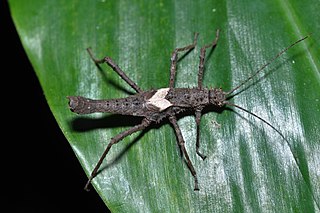
Haaniella parva is a species of stick insect from the subfamily Heteropteryginae and belongs to the representatives of the genus Haaniella native to Sumatra. It is their smallest representative.
Pterobrimus is a monotypic genus of stick insects (Phasmatodea), containing the species Pterobrimus depressus, which is native to Fiji.


















